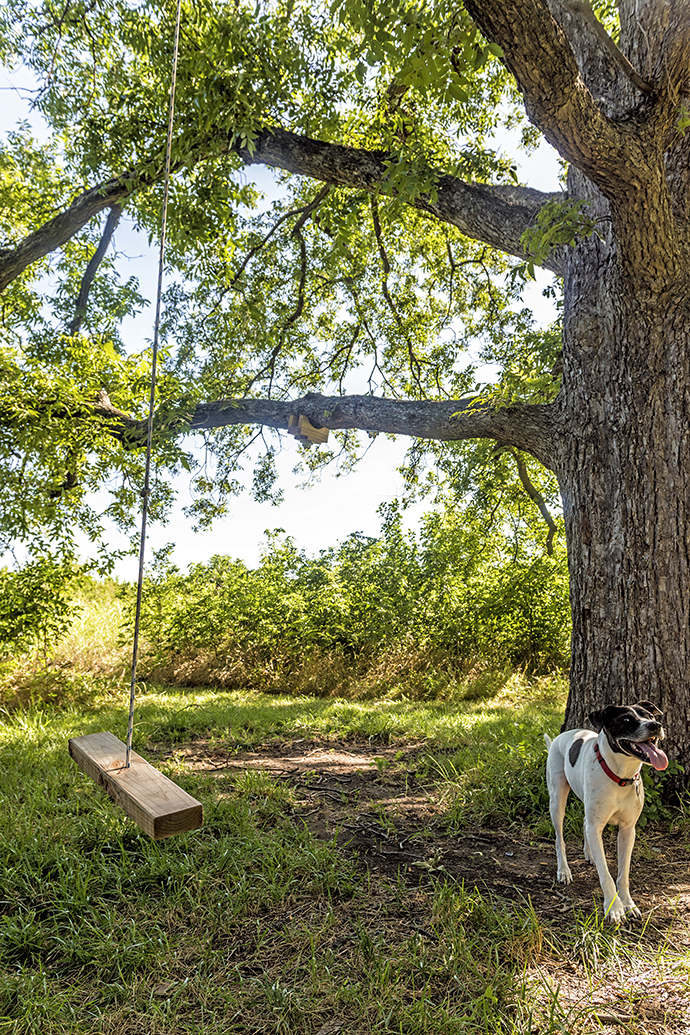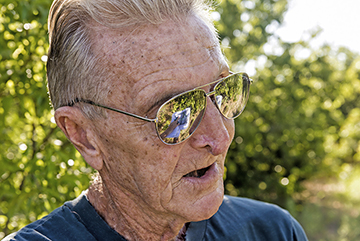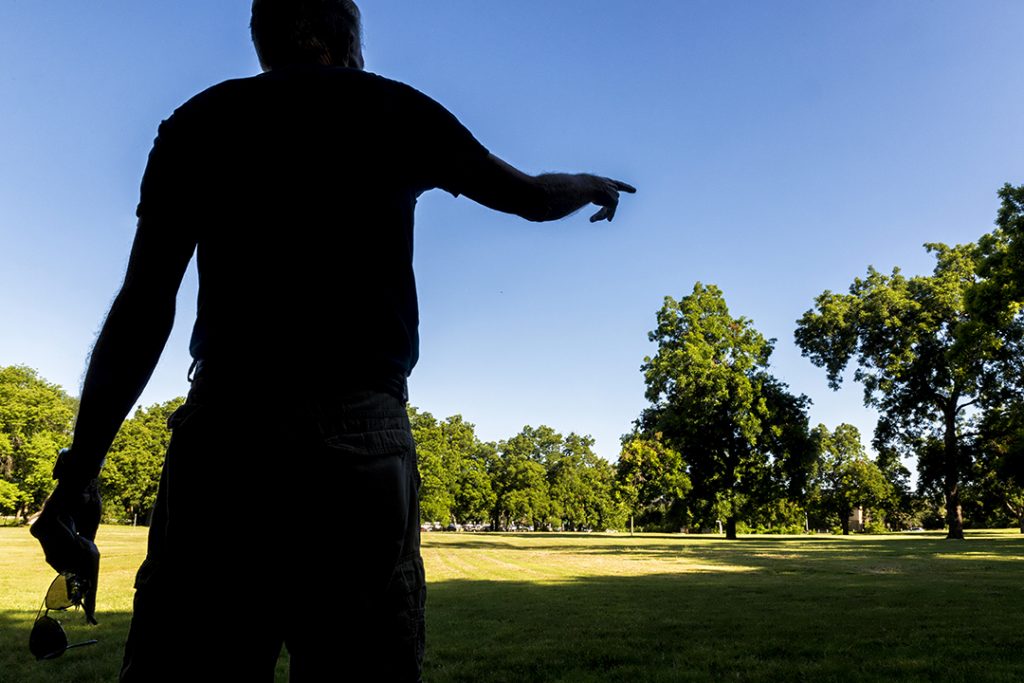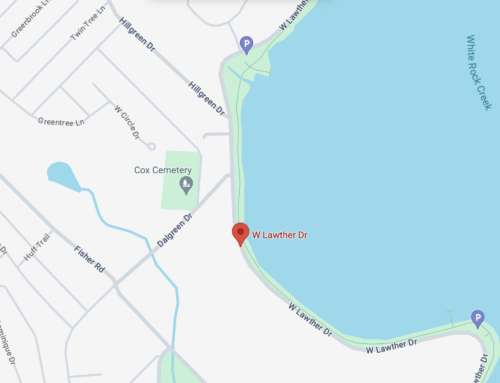
Click to see a larger map of Harry S Moss Trails at happytrailsdallas.com/trail-maps (Map courtesy of the City of Dallas)
The parkland, which runs alongside upper Greenville Avenue between Walnut Hill and Royal Lane, is, to youngsters, the soccer complex. To off-road cyclists, it is 5.46-miles of single-track dirt trail. The northern portion of the land offers parking and access to wide-open green space — for picnics or ball tossing — and White Rock Creek Trail, a bona-fide artery of Dallas’ extensive trail network. USA Today even noted, in its guide to honeymooning in Dallas, “lightening bugs who thrive in the margins between stream banks and damp, temperate woodland … The sight of tens of thousands of fireflies blinking in the dark night is magical,” the writer continues, “and a stroll through a vast meadow alive with their enchanting and captivating light is supremely romantic.”
For a few, Moss is all of that and more — sacred land with an engrossing history and hidden surprises, such as a network of primitive footpaths and remnants of a short-lived horseracing track.
A small group of neighborhood retirees, for example, have taken it upon themselves to care for what they say are the forgotten regions of the city-owned land. A native grassland portion of Moss occurs along Arborside Drive. Near a City of Dallas sign, usually obscured by overgrowth, a small, wooden bridge covers a deep, narrow gully.
“Now this is the only way you can get in here. We put this here,” says Bill Grunnah, one of the grassland’s self-appointed caretakers, as he steps across the whitewashed planks, following his dog, Muttley. Over the bridge, an abbreviated path opens to a broad, emerald clearing.
“We call it the cathedral,” he says. Alone in the opening, the whistling birds and crunch of a few leaves underfoot might be the only sounds. Sunlight peeks through treetops. All around, a wall of towering grass — also a swing dangling from a branch — sways to a slight breeze.
Grunnah points at the tall thicket of intermingled stalks, sunflowers and weeds and says, “If not for Jim, all of this would be like that.”
The hollow, Grunnah continues, “is mowed by a gentleman named Jim. I don’t know his last name. I see him every week or two when he is walking his dogs, or mowing on his John Deere.”
The surrounding area is one of Dallas’ few remaining swaths of native prairie vegetation. On temperate mornings, a handful of neighbors — their off-leash dogs typically nearby — greet one another and rehash recent coyote and snake sighting. They rest on benches situated against tree trunks. Grunnah and his neighbors installed the amenities — the seats and swing. “We had two more benches,” Grunnah says. But one was stolen and wild bushes obscure another. (City staffers have since removed the swing and remaining benches).
“It’s an unofficial dog park,” Grunnah adds. “People don’t pick up the poop, but it’s so big no one really cares.”
Service area manager Jeremy McMahon says the dog park/cathedral, also dubbed the “wedding area,” is illegally landscaped; that is how the city views it until those responsible sign a beautifucation agreement that would approve them to mow that area. “We found out through the homeowners association who was doing it and sent them the agreement,” he says, “but they have not sent it back.” A tributary of the “cathedral” leads to a system of muddy, horse-hoof pocked trails Grunnah has spent many an hour picking up junk along the trails, which accumulates by the ton when it when it rains.
“I do the trash. A couple other guys do the mowing and weed-whacking,” Grunnah says.
There are others, people he doesn’t know, who bring tractors and mowers in an effort to maintain these old trails.
“Just the other day I saw a girl riding a white horse and then up behind her came this Bobcat-type tractor, and it scared the heck out of her, but that’s what it’s come to,” he says.
McMahon reiterates that none of these rogue landscapers (some in the Park department call them the “Sacred Moss Accord”) have an official partnership with the city, though they could if they went through the proper channels.
“If they signed the agreement, they could even continue to maintain those trails if they like.” Some resist an official agreement, Grunnah allows.
“Some say they like it as it is, because they like no one knowing about what’s back here.”
But Grunnah at least likes to see the city mow and maintain the blackland prairie at Moss, which he says has “fallen through the cracks.”
About that part, he’s correct, McMahon says. While the city has neither resources nor plans to maintain the so-called cathedral or the old trails, McMahon says, they are responsible for the 25 or so acres of blackland prairie. He says it has fallen by the wayside for the past several years, due to a lack of manpower and know-how.
“Right now we are working with a native restoration expert and the Office of Risk Management, and we are eager to get that started,” McMahon says. “It takes a special expertise to get that right — know what to pull, what to mow. All we want is for all of these things to be done the right way.”
As he leads us along the footpaths, Grunnah, enamored with the park’s history, points out that, for a brief period while pari-mutuel betting was legal, from 1933-35, a racetrack existed here. He points out the fossil of an antique structure he says was part of the track. An aerial photo from the 1930s (above) shows a circular track on the spot. Much of his Moss wisdom comes from the research of SMU professor and historian Ted Campbell, who verifies the racetrack story. It was called Hilltop Stables. Promoter R.B George in 1933 assured a Dallas Morning News reporter that “there is no guesswork to this at all. We are going to have one of the greatest racing stables in this country.” Campbell jokes that the name Hilltop Stables “ranks among dumb place names that must have seemed fanciful to developers.” The track was right in the flats along White Rock Creek, he says, “which we all know regularly floods the entire area.”
Fittingly, Harry S. Moss, who later acquired the property, was one of the “most colorful residents of this area in the mid-20th century,” Campbell says. The Canada native moved to Texas in 1906 and started the Moss Petroleum Company in 1920. He lived in Highland Park, but in 1930 he bought a bull at the State Fair and realized he had no place to keep it, Campbell says. So he bought and built the 400-acre Moss Haven stock farm. The Moss house still exists, albeit modified, near Moss Haven Elementary and was featured in the 1958 Architectural Digest.
In the late 1960s and early ‘70s, the City of Dallas purchased 54 and later another 225 acres of that farm, an acquisition that played a lynchpin role in then Park Director L.B. Houston’s green belt plan, the origins of today’s Dallas trail system. Dallas Arboretum founders briefly considered some of the land for the city’s botanical gardens, but ultimately deemed the DeGloyer Estate more apropos.
Over the years the land has seen its share of tragedy. Wooden crosses and a bench mark the location of jogger David Stevens’ senseless and violent murder last year. Grunnah months ago called in an apparent suicide after he says a man passed him, waving amicably, before he heard one fatal gunshot.
Sunflowers, their seed sprinkled all over the land by a woman years ago, once tall and prominent are now shrouded by weeds, Grunnah points out.
There is so much beauty here, he says, but you have to take care of it, look for it, appreciate it.














